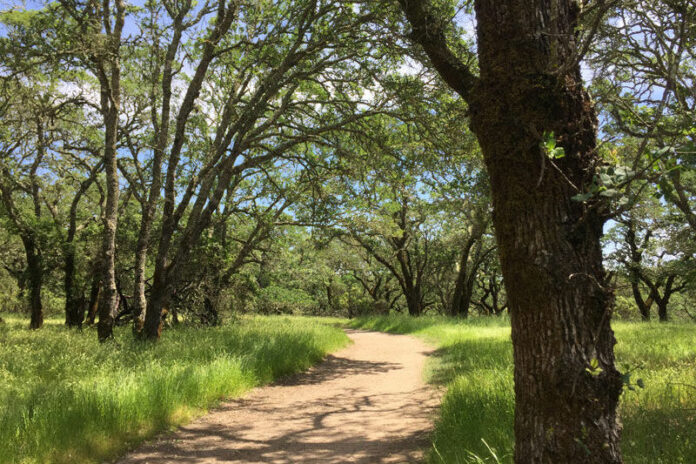
As the pandemic wears on, the eighth COVID-19 Town Hall from Northern California Public Media brought good news and bad news to Sonoma County residents. The good news is that local parks will be reopening this week — though only for those who can get there on two legs (or two wheels). The bad news is you’ll be eager to take advantage of those outdoor opportunities because the shelter-in-place order is about to be extended.
“So many community members have reached out to the supervisors … saying ‘We want access to our parks!’ We’ve heard you, and we’ve been advocating for this to happen,” said Susan Gorin, chair of the Sonoma County Board of Supervisors.
Gorin called it “a soft opening” of the parks, noting that the park will remain closed to automobiles.
“You’ll have to find the closest park to your house so that you can walk or ride your bike,” she said.
Though local and regional parks will be reopened, beaches will remain closed, she said.
Later in the program, Sonoma County Health Officer Sundari Mase added that people will be required to maintain a social distance of at least six feet in the parks and will also need to carry a mask—though they don’t necessarily need to wear it. Mase said parks will open for on-trail hiking and biking, but that picnics, off-trail hiking and large gatherings in the park are still off-limits. She said that park goers’ cars spotted in park parking lots (or even in nearby neighborhoods) would be cited.
She also encourage people to use common sense.
“If you arrive at the park and it looks really busy, just turn around and go home and plan to return at a later time.”
Mase also confirmed that she would be extending the shelter-in-place order though she declined for the moment to say for how long. Six other Bay Area counties announced on Monday that they were extending the shelter-in-place order until May 31. Mase said she will be announcing the extension later in the week and will provide an ending date at that time.
Crushing the curve
Mase said that Phase Two modelling shows that Sonoma County has been spectacularly successful at flattening the curve, so much so that even at peak case load, she doesn’t expect it to threaten the abilities of local health care resources to respond.
“It seems like shelter in place has been incredibly effective,” Mase said. “I think that’s really the main message that we have from the new modeling. It looks as if it was much more effective than even the modelers predicted. We thought that the shelter in place would reduce transmission of the virus from one person to another by about half, but it’s actually more like 75%,” she said, noting that that meant that each new COVID-19 case was passing on the virus to fewer than one other person.
Mase thanked community members for their strict adherence to the shelter-in-place order and said they were responsible for the fortunate position Sonoma County finds itself in: with only 227 cases, half of those recovered, half active, and still only two deaths.
In fact, Mase said, the surveillance testing that the county has been doing has thus far found no cases among at-risk populations like jail inmates, the homeless and the elderly in congregate settings like assisted living or skilled nursing facilities.
The only way to preserve the county’s low case count, Mase said, is to step up mitigation measures — such as extensive testing and contact tracing — as the county begins to slowly and carefully lift one restriction at a time.
At a briefing earlier in the day, Mase said the county was currently conducting around 200 tests a day and that it planned, with the help of the state, to increase that to 600 to 800 cases a day next week.
She said tests would be available to the following groups in this order: health care works who are either symptomatic or asymptomatic; first responders who are symptomatic or asymptomatic; people over 65 and people with underlying medical conditions who are symptomatic; essential infrastructure workers who are symptomatic; and then, after that, members of the general community who have symptoms of the virus.
“I think within the next several weeks we’ll be seeing widespread community testing as well,” Mase said.
Mase also said the county has stepped up its contact tracing.
“Right now our disease control nurses follow up with all of the contacts to our cases,” she said. “And we have people, volunteers at home, that are actually calling the contacts every few days to see if they’re going to become symptomatic. We also test all of our contacts at about seven days after they’re initially identified. And what we’re planning to do is scale that up,” she said.
Looking forward
Even though the county is planning to extend shelter-in-place, Mase said it’s also looking to the future when shelter-in-place will end.
Mase said the county was considering easing restrictions on certain businesses like construction in the near future. She also said, “We are working with different businesses and entities to try to establish plans and best practices for when we do open up — things like social or physical distancing, facial coverings and temperature checks.”
Mase said the county plans to repeal restrictions slowly, one at a time, so it can gauge their effect.
“We are going to closely monitor what happens as we loosen our restrictions and see if we’re having a lot more cases,” she said.




